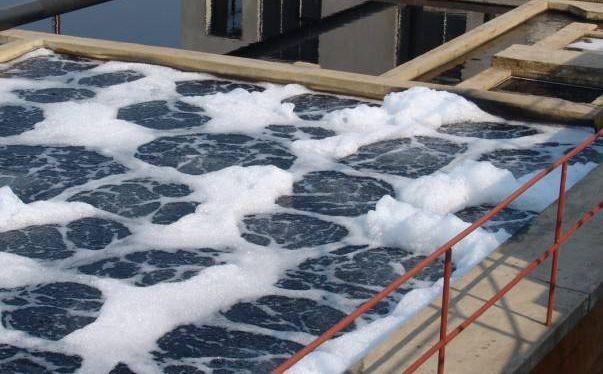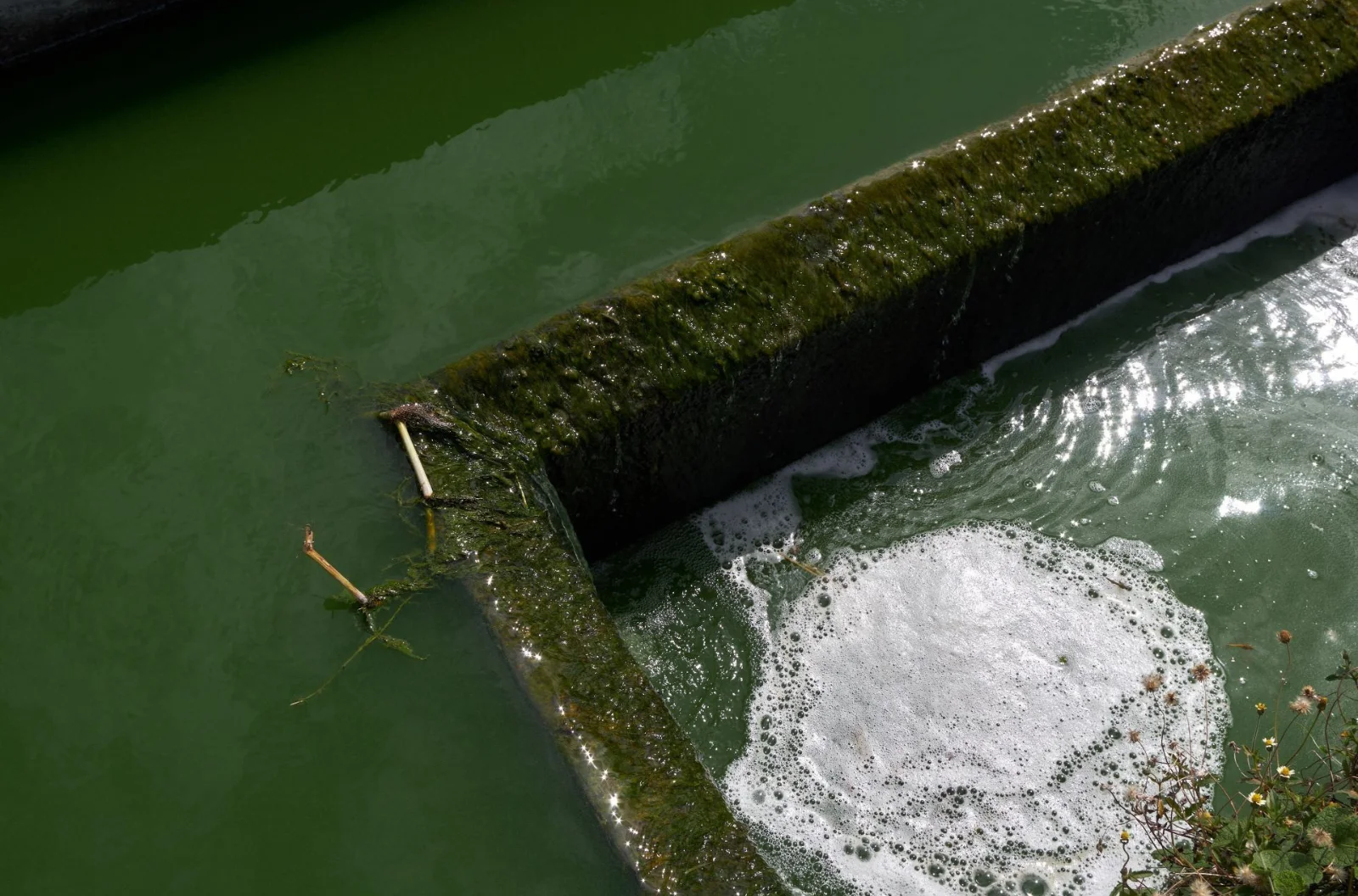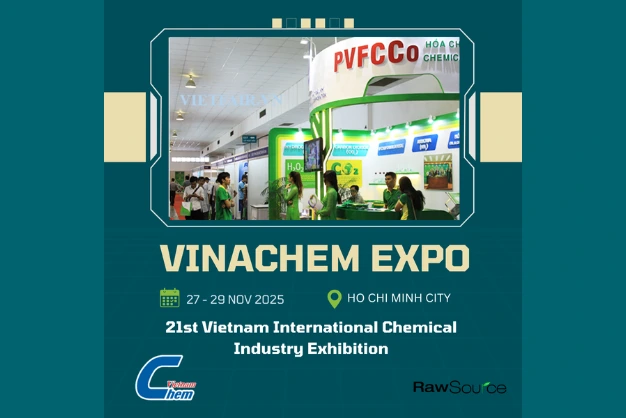Wastewater treatment is essential for managing water resources, ensuring environmental compliance, and supporting sustainable development. However, foam generated during various treatment stages often disrupts processes and decreases efficiency. Foam forms due to the presence of surfactants, biological activity, and impurities, leading to issues such as equipment overflow, reduced aeration efficiency, and sludge processing challenges.
Defoamers provide a practical solution by controlling foam formation and breaking down existing foam. Their application in wastewater treatment not only improves operational efficiency but also ensures consistent output quality, making them indispensable in modern treatment plants.
How Defoamers Work in Wastewater Treatment?
Defoamers act by disrupting the stability of foam. Foam consists of gas trapped in a liquid, stabilized by surfactants. Defoamers intervene in the following ways:
1. Reducing Surface Tension: Defoamers spread across the foam surface, weakening the surfactant film that stabilizes bubbles. This action destabilizes the foam structure, allowing bubbles to break more easily and preventing new foam from forming.
2. Breaking Foam Structure: Insoluble droplets of defoamers penetrate the foam, disrupting its physical integrity. This causes the foam bubbles to collapse quickly, reducing the volume of foam present in the system.
3. Promoting Bubble Coalescence: Defoamers encourage smaller foam bubbles to merge into larger ones, which rise to the surface and dissipate. This reduces the overall foam density and ensures quicker elimination.
Types of Defoamers in Wastewater Treatment
- Silicone-Based Defoamers: Highly effective across a wide range of temperatures and environmental conditions, these defoamers are commonly used in aeration and sludge treatment processes due to their stability and performance.
- Oil-Based Defoamers: Suitable for handling foam in processes involving heavy oils, greases, or organic matter, these defoamers excel in industrial wastewater applications.
- Water-Based Defoamers: Often preferred in environmentally sensitive applications, water-based defoamers are eco-friendly and biodegradable, making them ideal for sustainable wastewater management.
By addressing the root cause of foam, defoamers ensure uninterrupted operations and improve overall system performance.


How Defoamers Improve Efficiency?
Foam control directly impacts the efficiency of wastewater treatment plants by optimizing several key processes:
Enhanced Oxygen Transfer
In aeration tanks, foam can block oxygen diffusion, which is critical for the survival and activity of microorganisms responsible for breaking down organic matter. When foam covers the surface, it creates a barrier that inhibits the transfer of oxygen from the air to the water. Defoamers eliminate this foam, maintaining clear surfaces and ensuring optimal oxygen levels. This improvement enhances microbial activity and accelerates the degradation of organic pollutants.
Improved Sludge Processing
Foam in sludge processing units can hinder dewatering and settling, leading to inefficiencies in solid-liquid separation. Sludge with excessive foam is more difficult to process, often requiring additional energy and resources. Defoamers reduce foam volume and improve the flow of sludge, facilitating smoother operation of dewatering equipment like centrifuges and belt presses. This results in drier sludge and lower disposal costs.
Reduced Energy Consumption
Foam buildup increases resistance in pumps, blowers, and mixers, forcing equipment to work harder and consume more energy. This additional strain can lead to higher operational costs and frequent maintenance needs. Defoamers prevent foam-induced resistance, allowing equipment to operate at optimal efficiency. This reduction in energy consumption translates to significant cost savings over time.
Better Chemical Dosing Accuracy
Foam can interfere with the precision of chemical dosing systems, leading to inconsistent results in coagulation, flocculation, or pH adjustment processes. For example, foam can obstruct the delivery of treatment chemicals, causing uneven distribution and suboptimal reactions. Defoamers eliminate foam interference, ensuring that treatment chemicals are delivered accurately and consistently. This improves the overall effectiveness of the chemical dosing process.
Minimized Equipment Downtime
Foam-related issues can cause wear and tear on equipment, leading to frequent maintenance and unplanned downtime. Foam overflow can damage components such as seals, valves, and pumps, reducing their lifespan. Defoamers prevent such damage by controlling foam at its source, ensuring that equipment runs smoothly and reliably. This not only increases operational uptime but also reduces maintenance costs.
Looking for High-Quality Chemicals?
We offer a wide range of products for diverse industries.
Key Applications of Defoamers in Wastewater Treatment
Defoamers are integral to several stages of wastewater treatment, addressing specific foam-related challenges:
Aeration Tanks
Aeration is a critical step in wastewater treatment, where microorganisms break down organic matter. Foam in aeration tanks can block oxygen transfer, reducing the efficiency of biological treatment. By controlling foam, defoamers maintain clear surfaces and optimize oxygen diffusion, which is essential for the activity and growth of beneficial microorganisms. This results in faster and more efficient treatment of organic pollutants.
Sludge Dewatering
Foam during sludge processing can reduce the efficiency of dewatering equipment, leading to higher moisture content in processed sludge. Excess foam increases the workload of dewatering systems and can result in inconsistent results. Defoamers enhance the performance of centrifuges and belt presses by minimizing foam-related obstructions, ensuring effective water removal and producing drier sludge that is easier to handle and dispose of.
Effluent Treatment
In the final stages of wastewater treatment, foam can compromise the clarity and quality of treated water. Foam can interfere with sedimentation and filtration processes, leading to water that does not meet discharge standards. Defoamers improve water clarity by eliminating foam, ensuring that the treated water meets regulatory requirements for environmental compliance.
Chemical Dosing Systems
Accurate chemical dosing is essential for coagulation, flocculation, and pH adjustment in wastewater treatment. Foam in chemical dosing systems can lead to uneven distribution of chemicals, reducing their effectiveness. Defoamers eliminate foam in dosing equipment, ensuring precise and consistent chemical delivery, which is crucial for achieving desired treatment outcomes.


Challenges of Foam in Wastewater Treatment
Foam is caused by various factors, including the presence of surfactants, high biological activity, and chemical reactions. While it might seem harmless, foam can create significant challenges:
1. Interruption of Aeration Processes: Foam reduces oxygen transfer, slowing down biological treatment by limiting the activity of microorganisms.
2. Overflow in Tanks and Equipment: Excessive foam can cause spills, operational disruptions, and potential damage to equipment.
3. Reduced Efficiency in Sludge Settling: Foam interferes with the separation of solids and liquids, impacting sludge dewatering and disposal. This leads to higher processing times and lower-quality results.
By addressing these challenges, defoamers play a pivotal role in maintaining efficient wastewater treatment operations.
Need Reliable and Efficient Chemical Products?
Let us help you find the perfect match for your needs.
Selecting the Right Defoamer for Wastewater Treatment
Choosing the appropriate defoamer depends on several factors, including compatibility with the treatment process, environmental considerations, and cost-efficiency. Key points to consider include:
- Chemical Composition: Ensure the defoamer is compatible with the treatment system and does not introduce harmful byproducts. Formulations should align with the specific needs of the wastewater being treated.
- Environmental Impact: Opt for biodegradable and eco-friendly defoamers to minimize environmental harm while maintaining high performance.
- Effectiveness and Cost: Balance performance with cost-effectiveness to ensure sustainable operations without compromising quality.
Defoamers are critical in improving the efficiency of wastewater treatment plants. By addressing foam-related challenges, they enhance oxygen transfer, improve sludge processing, reduce energy consumption, and ensure accurate chemical dosing. Their applications span various stages of treatment, making them indispensable for maintaining operational efficiency and meeting environmental standards. As technology advances, the adoption of eco-friendly defoamers promises to further optimize wastewater treatment processes, contributing to a cleaner and more sustainable future.
FAQs
What is the purpose of a defoamer?
The primary purpose of a defoamer is to eliminate or prevent foam formation in industrial and manufacturing processes. Foam can disrupt operations, reduce the efficiency of equipment, and compromise the quality of products. By breaking down bubble formations and reducing surface tension, defoamers ensure smooth operations and maintain consistency in outcomes.
What is defoamer in water treatment?
In water treatment, defoamers are agents specifically used to manage foam that occurs during processes like aeration, biological treatment, or chemical dosing. Foam in these systems can hinder oxygen transfer, disrupt settling tanks, and cause overflow issues. Defoamers effectively address these challenges, enhancing the clarity of treated water and ensuring efficient equipment performance.
What is the purpose of an anti-foaming additive?
Anti-foaming additives are used to prevent foam from forming in the first place. These additives function by reducing surface tension in liquids or destabilizing bubbles as they develop. Their purpose is to maintain optimal process efficiency, improve product quality, and prevent delays or damage caused by excessive foam during manufacturing.
Is it necessary to use a defoamer?
Using a defoamer becomes essential when foam presents significant operational challenges or compromises the quality of the process. Foam can interfere with machinery, slow down operations, and lead to inconsistencies in product quality. Defoamers provide a reliable solution to ensure uninterrupted workflows and improved outcomes, making them indispensable in various industries.
What can I use instead of a defoamer?
Alternatives to defoamers can include mechanical methods like baffles or sprays to physically break foam, process modifications such as reducing agitation or adjusting temperatures, or the use of natural substances like vegetable oils to control foam. However, these alternatives may not always provide the same efficiency or versatility as chemical defoamers, particularly in environments with persistent or high levels of foam.





